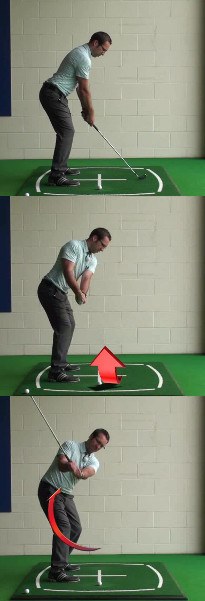In golf, an “on-plane” golf swing refers to a swing motion where the clubhead follows a consistent and proper path relative to the golfer's body and the target line. It involves keeping the club on a consistent plane or angle throughout the swing, leading to more consistent ball striking and improved accuracy.
Here are a few key points about an on-plane golf swing: 
- Swing Plane: The swing plane is an imaginary plane that represents the path the clubhead travels during the swing. It is often described as an inclined plane that extends from the ball through the golfer's shoulders. The swing plane can vary based on a golfer's height, build, and swing characteristics, but the goal is to maintain a consistent and repeatable plane throughout the swing.
- Proper Body Alignment: To achieve an on-plane swing, it's important to set up with proper body alignment. This involves aligning your feet, hips, and shoulders parallel to the target line. Aligning yourself properly at address sets the foundation for a more on-plane swing.
- Backswing: During the backswing, the club should move on or slightly above the established swing plane. This means the clubhead should not excessively drop to the inside or lift too far above the plane. A proper backswing keeps the club on a relatively consistent path, with the hands, arms, and body working together to rotate and maintain the club's position on the plane.
- Downswing: In the downswing, the club should return to the same plane it was on during the backswing. This means the clubhead should not swing too far from the inside or outside of the intended swing plane. A proper downswing allows the club to approach the ball from a consistent angle, leading to solid contact and improved accuracy.
- Follow-Through: After impact, the club should continue to move along the established swing plane during the follow-through. This ensures a smooth and balanced finish to the swing.
Achieving an on-plane golf swing requires practice, proper technique, and awareness of your swing mechanics. It is recommended to work with a qualified golf instructor who can help analyze and guide your swing to ensure you are staying on-plane throughout the entire motion. Video analysis, training aids, and drills can also be beneficial in developing and maintaining an on-plane swing.
By maintaining an on-plane swing, golfers can improve their consistency, ball striking, and overall performance on the golf course.
Q&A on Maintaining an On-Plane Golf Swing:
- What is an on-plane golf swing? An on-plane golf swing refers to a swing where the club follows a consistent path that matches the plane established at address, leading to more consistent ball striking.
- Why is maintaining an on-plane swing important? An on-plane swing promotes better ball contact, accuracy, and consistency, resulting in improved shot-making and overall performance.
- How can I establish the correct swing plane at address? Address the ball with the clubface square to the target line and ensure that the shaft aligns with your body's inclination, creating the desired plane.
- What are some common causes of an off-plane swing? Poor setup, incorrect takeaway, and over-the-top downswing motions can lead to an off-plane swing.
- How can I practice maintaining an on-plane swing? Use alignment sticks or training aids to guide your swing path. Focus on a smooth takeaway and transition while keeping the club on the established plane.
- What role does the takeaway play in an on-plane swing? The takeaway sets the foundation for an on-plane swing. A proper takeaway helps establish a correct backswing plane.
- Should I feel any specific sensations during an on-plane swing? You should feel that the club moves naturally along the plane without drastic adjustments or deviations.
- Can I use video analysis to check my swing plane? Yes, recording your swing and reviewing it with a golf instructor or using swing analysis software can help you identify any deviations from the desired plane.
- How can I prevent coming over the top during the downswing? Focus on initiating the downswing with the lower body while keeping the upper body and hands on a shallower plane, preventing a steep angle of attack.
- Can poor posture affect swing plane? Yes, poor posture at address can lead to incorrect club angles and affect the swing plane.
- Are there drills to help me maintain an on-plane swing? Yes, “One-Arm Drill” and “Bucket Drill” are popular drills that can help you feel and practice an on-plane swing.
- Can I fix my swing plane without a golf instructor? While self-correction is possible, working with a golf instructor can provide personalized guidance and quicker improvements.
- What about grip pressure and its impact on swing plane? Balanced grip pressure helps maintain control over the club, promoting a more consistent swing plane.
- Is an on-plane swing suitable for all golfers? Yes, an on-plane swing promotes consistency and accuracy, which benefits golfers of all skill levels.
- How can I transition from the backswing to downswing on-plane? Focus on initiating the downswing with a hip rotation, allowing the club to drop naturally onto the correct plane.
Remember that maintaining an on-plane swing requires practice and attention to detail. Regular practice, feedback, and potentially working with a golf instructor can help you develop and sustain an on-plane swing that improves your game.





